Dig into this doenjang jjigae recipe with abandon! This is proper Korean comfort food. It’s a savory simmered stew made with soybean paste, fiery gochugaru, tofu and veggies. Easy to make and vegan friendly. And it only takes 25 minutes to prepare from start to finish.
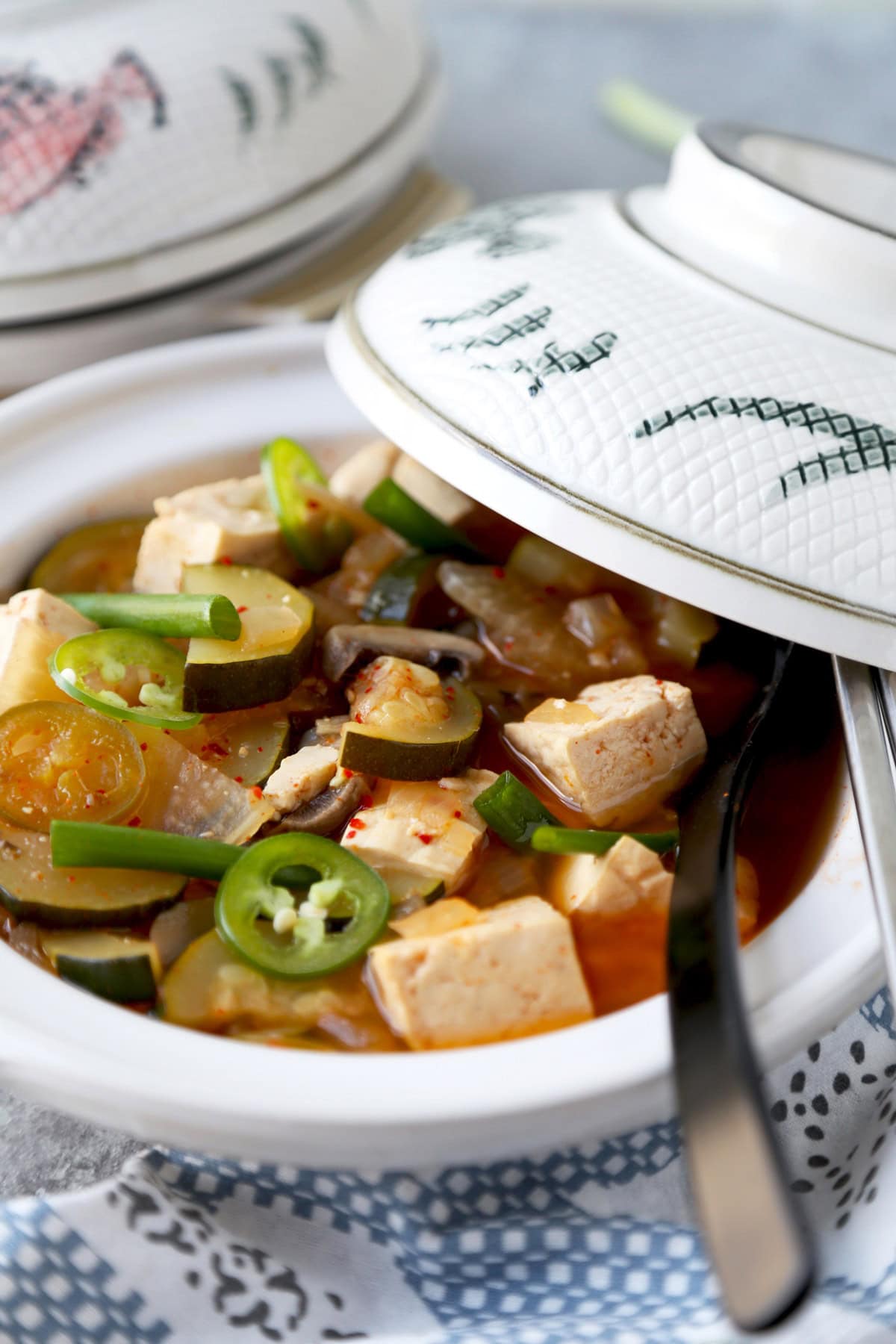
Why This Recipe Works
- Spicy, savory and funky. A ton of assertive, authentic Korean flavor with very few ingredients and little actual cooking.
- Versatile in terms of ingredients. You can follow this recipe to the letter, or just use up the veggies you already have handy in the fridge.
- Vegan if you want it to be. With a pescatarian option if you prefer.
Table of contents
What is Doenjang Jjigae
Doenjang jjigae (된장찌개) is a simmered Korean dish usually composed of meat, vegetables and tofu. It has a rich, savory and spicy flavor profile – and a viscosity that straddles the line between soup and stew. I’m making this version with daikon radish, tofu, zucchini, mushrooms and chili peppers. The main flavors come from dried chili pepper flakes and doenjang paste.
What is Doenjang Paste
Doenjang (된장) is a Korean paste made from fermented soybeans and salt (or brine). It has a salt-forward pungent and earthy flavor. Read about doenjang here. While there are some significant similarities to Japanese miso paste, doenjang is more aggressively pungent. Miso tends to be a bit more mild with sweet notes. You can use either doenjang or miso in this recipe.
Is Doenjang Jjigae Vegan?
It can be! If you just stick to the recipe as it’s printed below (with water and awase miso paste), this doenjang jjigae is vegan all the way.
Important note: Korean doenjang paste is traditionally made with only soybeans and salt. However some brands add fish (so if you’re using doenjang rather than miso paste, read the label before buying).
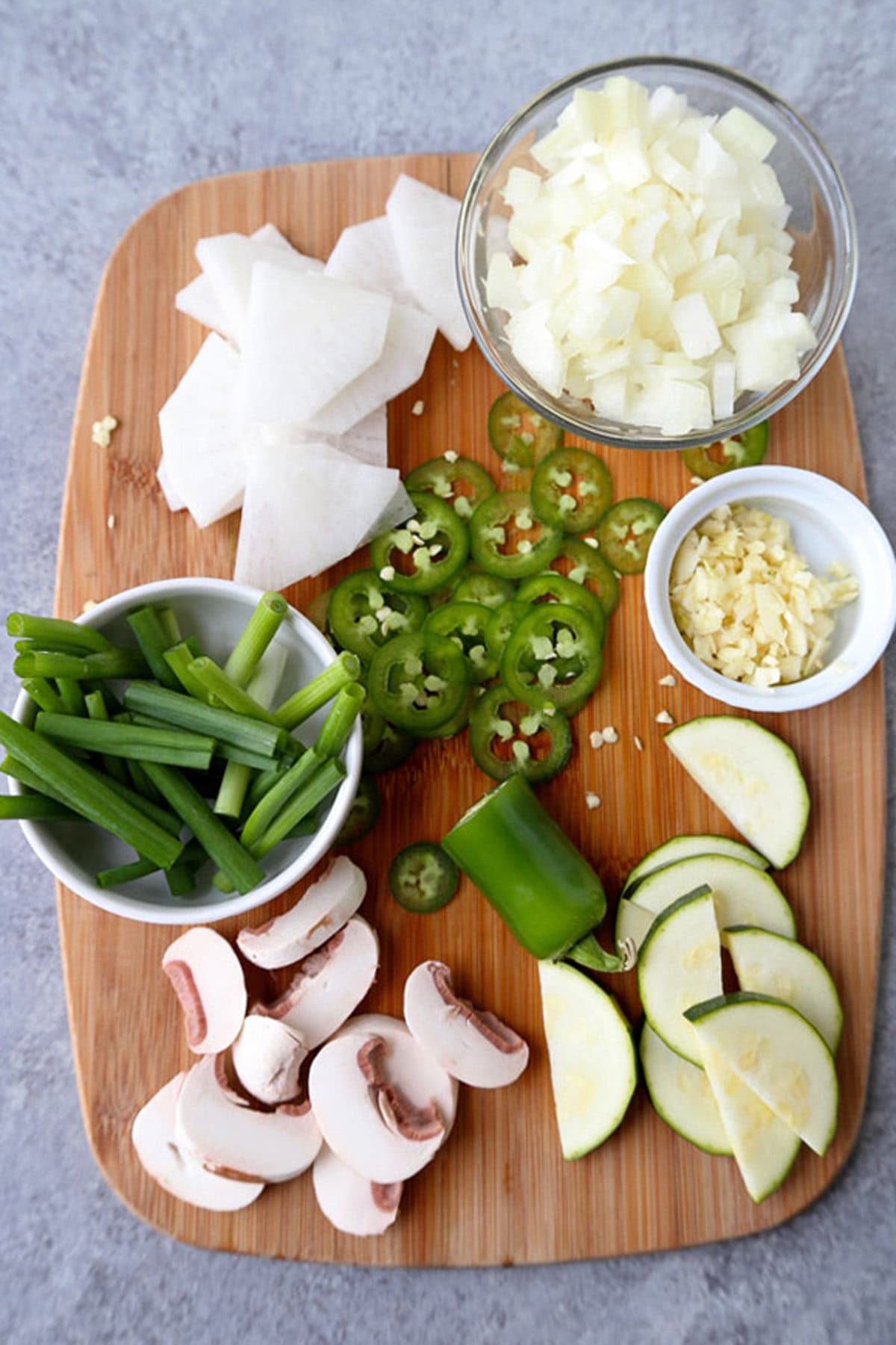
Doenjang Jjigae Ingredients
Scroll to the bottom of this page for the full recipe!
- Doenjang or Miso Paste: Your choice. Traditionally, you’d use doenjang (Korean fermented soybean paste). Personally, I use awase miso which is a mix of white and red miso paste.
- Water or dashi broth: A water base will keep this dish vegan. Dashi is a savory fish stock.
- Onions and Garlic: Sweet, pungent and fragrant!
- Dried Kelp (seaweed): Dried kelp infuses the broth with briny and mineral flavors.
- Gochugaru: These are Korean chili pepper flakes. They’re spicy and a little smoky.
- Zucchini and Mushrooms: You get umami from the mushrooms and a fresh, pliant crunch from sliced zucchini.
- Daikon Radish: Daikon is a winter radish with a mild flavor. As it cooks, it’ll absorb all the savory, spicy goodness from the broth.
- Tofu: You can use medium or firm tofu for a chewy bounce.
- Scallions: Sprinkle green onions on top of your dish just before serving.
- Fresh Korean Chili Pepper or Fresh Jalapeño: While these are optional, if you like it spicy, you know what to do. Otherwise, leave these fiery numbers out.
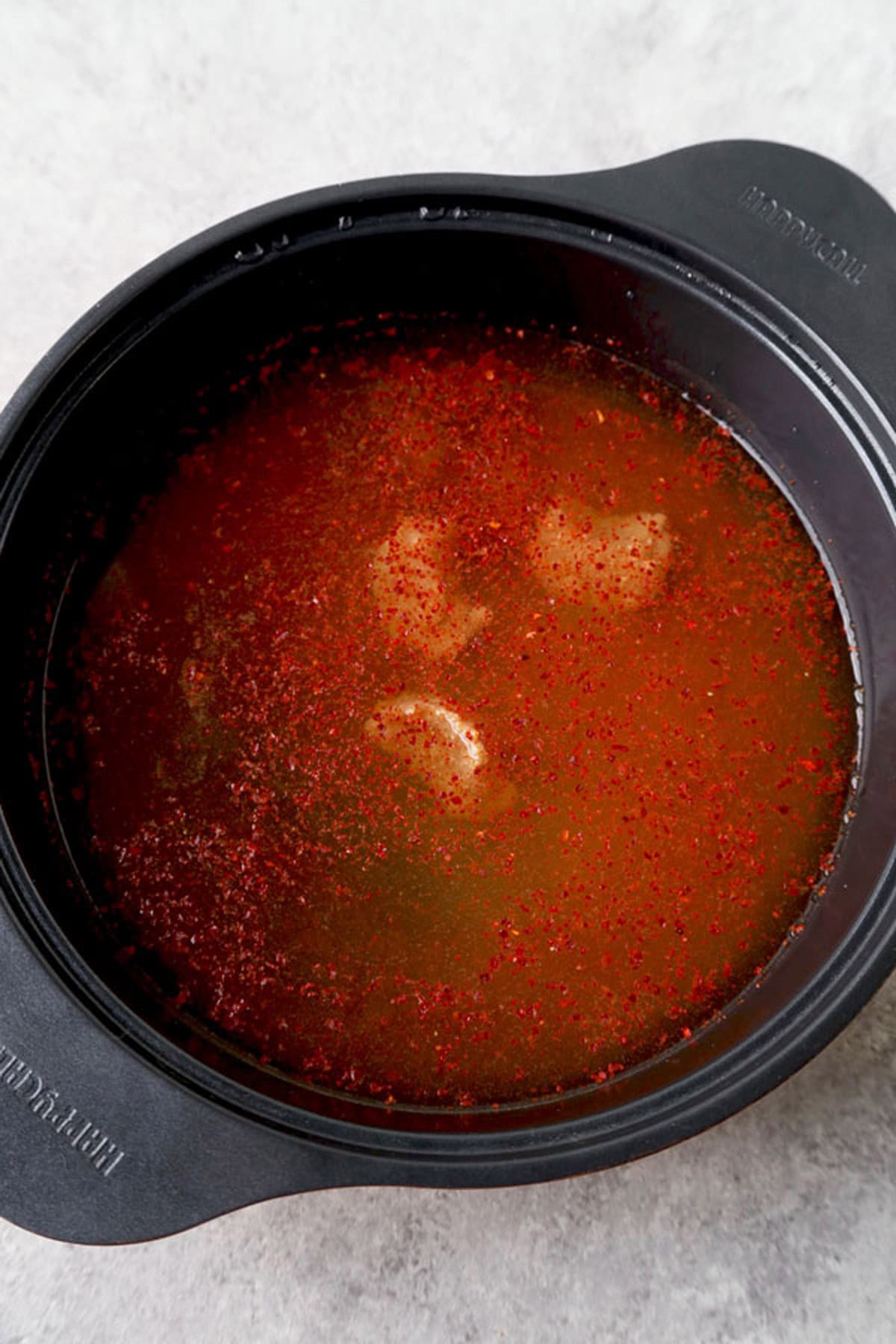
How to Make Doenjang Jjigae
- Pour 4 cups of water (or dashi broth) into a pot over medium high heat. Then add soybean paste, garlic, dried kelp and Korean chili pepper flakes. Bring to a boil.
- Then add the chopped zucchini, onion, mushrooms, daikon radish, tofu cubes, and thinly sliced chili pepper to the pot. Bring it back to a boil again.
- Once it’s bubbling, lower the heat to medium-low and let it simmer until your veggies are tender. Prioritize the zucchini. If it’s tender but still slightly crunchy around the outer edges, it’s ready. This shouldn’t take more than a few minutes.
- Do a taste test and adjust the flavor. Add a little extra soybean paste (or miso paste) if desired.
- Pull the kelp out and discard before serving.
- Ladel into serving bowls. Top with chopped scallions and serve.

Storage
Refrigerate any leftovers in a food storage container for up to 3 days.
- Reheat leftovers in the microwave or in a pan on the stovetop.
- Top reheated leftovers with chopped scallions for a fresh appearance and crunchy texture.
Frequently Asked Questions
You can track down what you’ll need for this doenjang jjigae at most Asian grocery stores. If you don’t live close to one, you can also pick things up here: doenjang or awase miso paste, gochugaru, daikon radish, and dried kelp. Everything else should be at your local food shop.
Korean doenjang paste is made solely from soybeans and salt, and is fermented to the point of earthy funkiness. It’s pretty assertive. Miso is a bit smoother, milder, and slightly sweeter. Miso is produced by adding rice and a koji starter to the soybeans before fermentation. Those subtle variations in production are responsible for the differences in flavor. However, you can totally substitute one for the other.
It can be as spicy or mild as you want it to be. The sliced jalapeño peppers are optional – and the Korean chili pepper powder (gochugaru) skews more smoky than blast-your-mouth spicy. If you’re sensitive to spice, go easy on the gochugaru.
Doenjang Jjigae dates back to the Three Kingdoms period. If you’re not up on your Korean history, that’s roughly 57 BC to 668 AD. During this time, Korea was primarily agricultural. Meat was scarce in the winter months. The water base is an ingredient most people already had on hand. While the daikon, a winter radish, would have been thriving during this region’s harsh winter climate. Even though it’s common to see meat and seafood in doenjang jjigae these days, scarcity of ingredients explains why this Korean dish didn’t traditionally have meat in it.
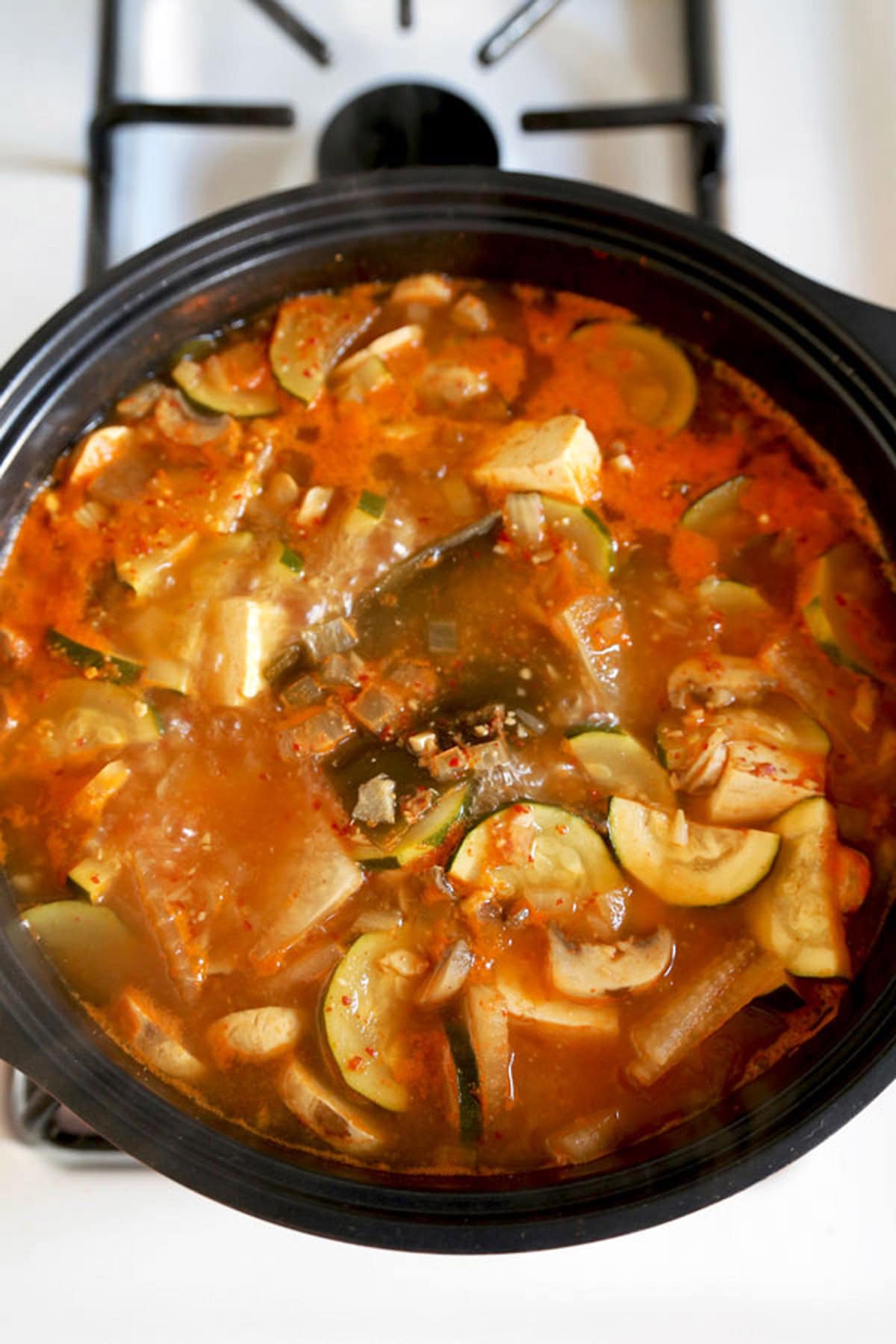
What to Serve With Doenjang Jjigae
Serve with a simple side of white rice. Or prepare a Korean feast with these easy additions:
- Korean Steamed Egg (Gyeran Jjim)
- Vegan Japchae – Korean Glass Noodles (잡채)
- Spicy Daikon Radish Salad (무생채)
- Korean Spicy Cucumber Salad (Oi Muchim)
- Korean Chive Pancake (Buchujeon)
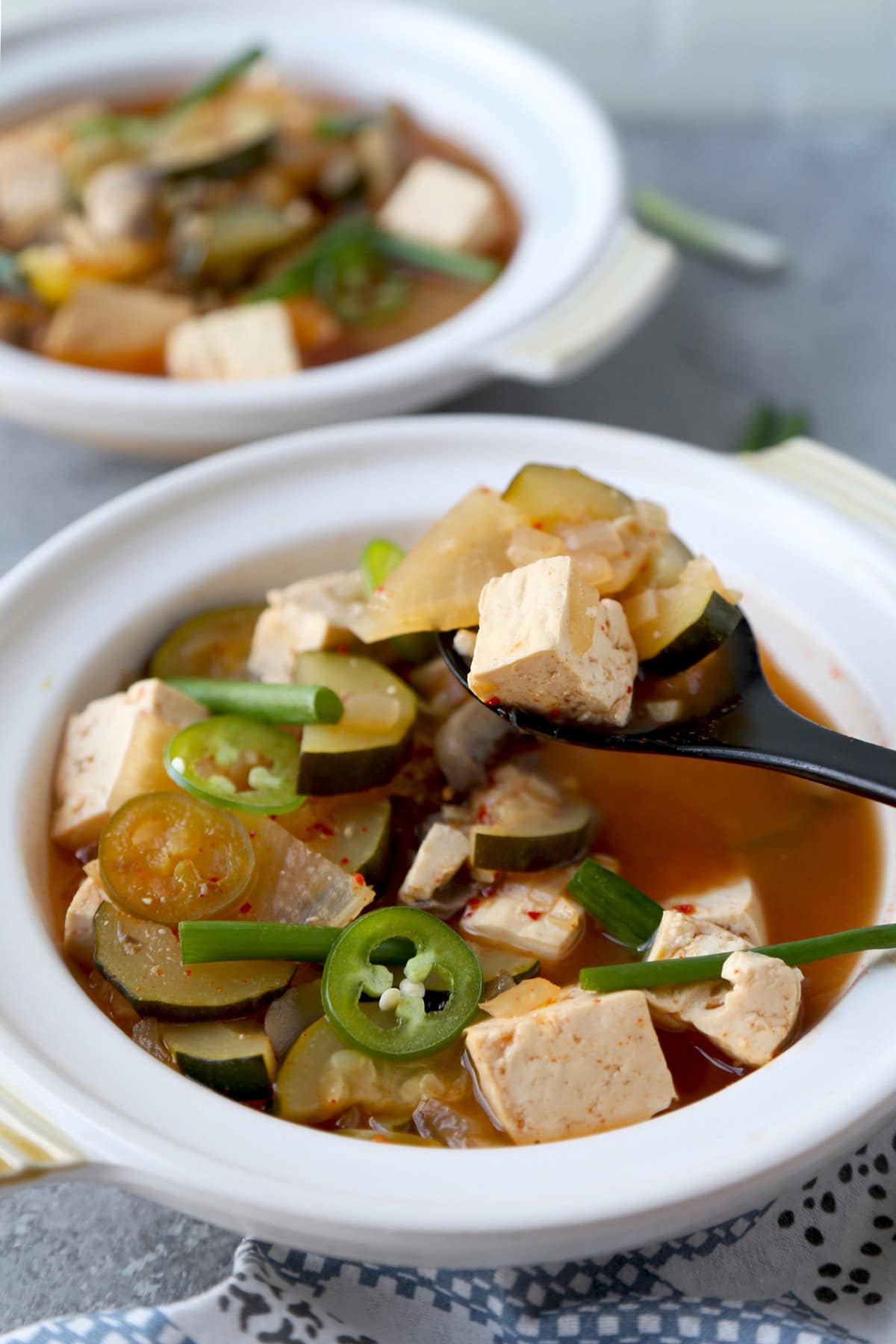
Subscribe to my newsletter and receive the latest recipes and weekly favorites straight to your inbox. Join me on Pinterest, Facebook, and Instagram for more cooking tips and adventures!
Did you like this doenjang jjigae recipe? Are there changes you made that you would like to share? Share your tips and recommendations in the comments section below!
Print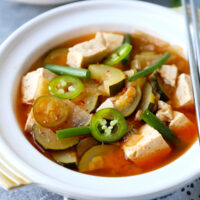
Doenjang Jjigae
- Prep Time: 10 minutes
- Cook Time: 15 minutes
- Total Time: 25 minutes
- Yield: Serves 4
- Category: Vegan
- Method: Simmered
- Cuisine: Korean
- Diet: Vegan
Description
This is a vegetarian Korean soybean paste stew loaded with tofu, vegetables, and all the savory goodness.
Ingredients
- 4 cups water (or dashi broth)
- 3 tablespoons doenjang (Korean fermented soybean paste) or miso paste (I use awase miso which is a mix of white and red miso paste)
- 3 garlic cloves, minced
- 1 2-inch piece dried kelp (seaweed)
- 2 teaspoons Korean chili pepper flakes (gochugaru)
- 1 large zucchini, cut into half moon slices
- 1 medium onion, diced
- 1 cup button mushrooms, quartered
- 1 cup Korean radish or daikon, cut into thin half moon slices
- 1 block (12-14oz) tofu (medium or firm), cubed
- 4 scallions, chopped
- 1 Korean chili pepper or jalapeño, thinly sliced (optional)
- Cooked rice, to serve with (optional)
Instructions
- In a pot over medium heat, add water, soybean paste, garlic, dried kelp, and Korean chili pepper flakes, and bring to a boil.
- Add zucchini, onion, mushrooms, radish, tofu and chili pepper, and bring to a boil.
- Lower heat to medium-low and simmer until all the vegetables are cooked – about 15 minutes.
- Do a taste test – adjust flavor by adding 1 or 2 tablespoons of soybean paste if needed.
- Pull the kelp out, divide into serving bowls, top with scallions and serve with rice.
Notes
Leftovers of this doenjang jjigae recipe will keep in the fridge for 2-3 days.
Nutrition
- Serving Size: 1 bowl
- Calories: 117
- Sugar: 2.4g
- Sodium: 13.6mg
- Fat: 5.2g
- Saturated Fat: 0.7g
- Unsaturated Fat: 2.4g
- Trans Fat: 0g
- Carbohydrates: 10.5g
- Fiber: 2.4g
- Protein: 9.9g
- Cholesterol: 0mg


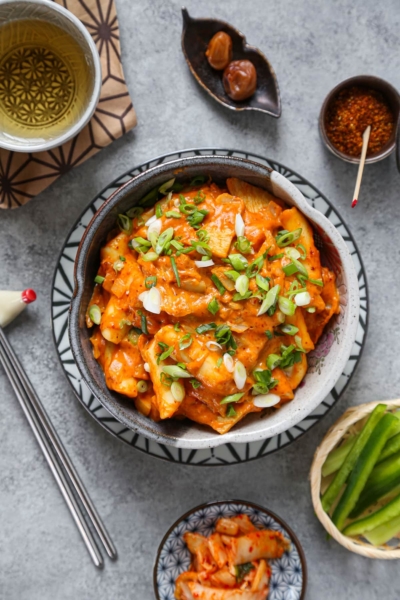
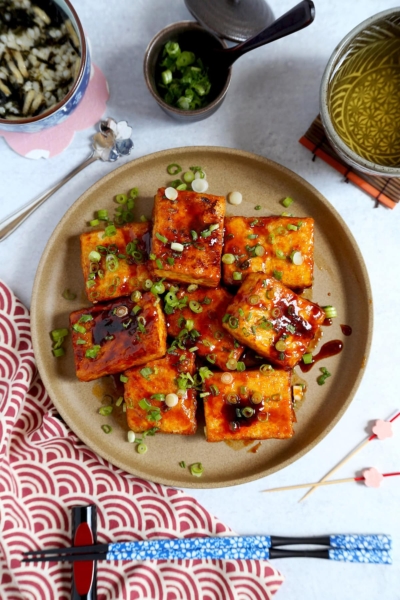














Questions and Reviews
I followed your recipe to the letter, and the stew was remarkable–both in its richness and its simplicity. Luckily I have an H-Mart nearby, so finding the ingredients was no problem, but I’m sure substitutions would work well too. Thanks so much for this. It’s going to be a staple dish in my house,
Thank you so much, Tom! 🙂
This was surprisingly easy and very tasty! I usedmiso, because that’s what I had. I didn’t have zucchini, so I subbed a carrot and a yellow bell pepper. Great on a cold, snowy night! My family really enjoyed it.
Hi, by daikon do you mean the pickled yellow one that you find at asian markets? Or just the raw white version?
Hi Avery! The raw white version is what you need for this recipe 🙂
I don’t have any daikon radish. Do you think this recipe will taste okay if I leave it out? Or should I run and go get some?
Hi Chris! The daikon absorbs all the flavors of the soup so I would say it’s a must. You can make it without but if you like daikon, you will love it in this recipe 🙂
Incredible! I added some enuki-mushrooms and soybeans for more texture (and better visuals). The more I ate the better it tasted haha. Suprised how much taste the soybean-paste had.
Ive now made this recipe twice and it will become a staple in my life! The flavour is so authentic and delicious! Ive also tried 2 of your other recipes – Jajangmyoen and the Japchae noodles – AMAZING! Kimchi fried rice and Kimchi pancake next! So happy to have found your site. These recipes are easy and authentic. What more could I hope for 🙂
Thank you so much for the kind words 🙂 I look forward to creating more Korean recipes!
I just returned from 2 weeks in South Korea. The best trip of my life. I am addicted to K drams, only listen to BTS on Spotify, love my k beauty sheet masks, my Samsung phone and ALL Korean food! I’ve stumbled upon your recipe whilst trying to re-live my Korean experience haha It sounds delicious, I will need to go to get all the ingredients and let you know how it goes. Ive watched about 50 dramas now. My absolute favs were: Healer, Goblin, weightlifting fairy, Strange Hero, I’m not a robot, Beauty inside, Legend of the blue sea, suspicious partner (anything that has Ji Chang Wook will be a winner) and touch your heart. Ive loved them all but these are my absolute favourites :)) Thank you for the recipe!
That’s so great Vanessa! There’s a drama called Let’s Eat that I love! There’s 3 seasons of it, the first one is on Netflix and the other two can be watched on the Viki app. I’ll check out your recommendations, thank you! 🙂
I live on that Viki app LOL Absolutely watch all of my suggestions! They are the best of the best in my world and I can’t see how anyone wouldn’t fall in love with them 🙂
Will do Vanessa, I’m super excited!
Vanessa, have you watched Romance is a bonus book on Netflix? I think that may be my favorite Korean drama